TP-Link TL-SL2428 User Manual

TL-SL2428
24-Port 10/100Mbps + 4-Port Gigabit Smart Switch
Rev: 1.0.0 1910010675

COPYRIGHT & TRADEMARKS
Specifications are subject to change without notice.  is a registered trademark of TP-LINK TECHNOLOGIES CO., LTD. Other brands and product names are trademarks or registered trademarks of their respective holders.
is a registered trademark of TP-LINK TECHNOLOGIES CO., LTD. Other brands and product names are trademarks or registered trademarks of their respective holders.
No part of the specifications may be reproduced in any form or by any means or used to make any derivative such as translation, transformation, or adaptation without permission from TP-LINK TECHNOLOGIES CO., LTD. Copyright © 2012 TP-LINK TECHNOLOGIES CO., LTD. All rights reserved.
http://www.tp-link.com
FCC STATEMENT
This equipment has been tested and found to comply with the limits for a Class A digital device, pursuant to part 15 of the FCC Rules. These limits are designed to provide reasonable protection against harmful interference when the equipment is operated in a commercial environment. This equipment generates, uses, and can radiate radio frequency energy and, if not installed and used in accordance with the instruction manual, may cause harmful interference to radio communications. Operation of this equipment in a residential area is likely to cause harmful interference in which case the user will be required to correct the interference at his own expense.
This device complies with part 15 of the FCC Rules. Operation is subject to the following two conditions:
1)This device may not cause harmful interference.
2)This device must accept any interference received, including interference that may cause undesired operation.
Any changes or modifications not expressly approved by the party responsible for compliance could void the user’s authority to operate the equipment.
CE Mark Warning
This is a Class A product. In a domestic environment, this product may cause radio interference, in which case the user may be required to take adequate measures.
Продукт сертифіковано згідно с правилами системи УкрСЕПРО на відповідність вимогам нормативних документів та вимогам, що передбачені чинними законодавчими актами України.
I
Safety Information
When product has power button, the power button is one of the way to shut off the product; When there is no power button, the only way to completely shut off power is to disconnect the product or the power adapter from the power source.
Don’t disassemble the product, or make repairs yourself. You run the risk of electric shock and voiding the limited warranty. If you need service, please contact us.
Avoid water and wet locations.
This product can be used in the following countries:
AT |
BG |
BY |
CA |
CZ |
DE |
DK |
EE |
|
|
|
|
|
|
|
|
ES |
FI |
FR |
GB |
GR |
HU |
IE |
IT |
|
|
|
|
|
|
|
|
LT |
LV |
MT |
NL |
NO |
PL |
PT |
RO |
|
|
|
|
|
|
|
|
RU |
SE |
SK |
TR |
UA |
|
|
|
|
|
|
|
|
|
|
|
II
|
|
|
CONTENTS |
Package Contents .......................................................................................................................... |
1 |
||
Chapter 1 About this Guide .......................................................................................................... |
2 |
||
1.1 |
Intended Readers ......................................................................................................... |
2 |
|
1.2 |
Conventions.................................................................................................................. |
2 |
|
1.3 |
Overview of This Guide ................................................................................................ |
2 |
|
Chapter 2 |
Introduction .................................................................................................................. |
5 |
|
2.1 |
Overview of the Switch ................................................................................................. |
5 |
|
2.2 |
Main Features............................................................................................................... |
5 |
|
2.3 |
Appearance Description ............................................................................................... |
5 |
|
2.3.1 |
Front Panel ........................................................................................................ |
5 |
|
2.3.2 |
Rear Panel ......................................................................................................... |
7 |
|
Chapter 3 Login to the Switch....................................................................................................... |
8 |
||
3.1 |
Login |
............................................................................................................................. |
8 |
3.2 |
Configuration ................................................................................................................ |
8 |
|
Chapter 4 |
System....................................................................................................................... |
10 |
|
4.1 |
System .................................................................................................................Info |
10 |
|
4.1.1 ............................................................................................. |
System Summary |
10 |
|
4.1.2 ........................................................................................... |
Device Description |
12 |
|
4.1.3 .................................................................................................... |
System Time |
13 |
|
4.1.4 ....................................................................................... |
Daylight Saving Time |
13 |
|
4.1.5 ......................................................................................................... |
System IP |
15 |
|
4.2 |
User Manage .............................................................................................................. |
16 |
|
4.2.1 ........................................................................................................ |
User Table |
16 |
|
4.2.2 ...................................................................................................... |
User Config |
16 |
|
4.3 |
System ..............................................................................................................Tools |
18 |
|
4.3.1 ................................................................................................. |
Config Restore |
18 |
|
4.3.2 .................................................................................................. |
Config Backup |
18 |
|
4.3.3 ........................................................................................... |
Firmware Upgrade |
19 |
|
4.3.4 ................................................................................................ |
System Reboot |
20 |
|
4.3.5 ................................................................................................... |
System Reset |
20 |
|
4.4 |
Access ..........................................................................................................Security |
20 |
|
Chapter 5 |
Switching ................................................................................................................... |
23 |
|
5.1 |
Port ............................................................................................................................. |
|
23 |
5.1.1 ....................................................................................................... |
Port Config |
23 |
|
5.1.2 ........................................................................................................ |
Port Mirror |
24 |
|
5.1.3 .................................................................................................... |
Port Security |
27 |
|
III
5.1.4 |
Port Isolation .................................................................................................... |
29 |
|
5.2 |
LAG ............................................................................................................................ |
|
30 |
5.2.1 |
LAG Table ........................................................................................................ |
30 |
|
5.2.2 |
Static LAG ........................................................................................................ |
32 |
|
5.3 |
Traffic Monitor............................................................................................................. |
33 |
|
5.3.1 |
Traffic Summary............................................................................................... |
33 |
|
5.3.2 |
Traffic Statistics ................................................................................................ |
34 |
|
5.4 |
MAC Address.............................................................................................................. |
36 |
|
5.4.1 |
Address Table .................................................................................................. |
36 |
|
5.4.2 |
Static Address .................................................................................................. |
38 |
|
5.4.3 |
Dynamic Address ............................................................................................. |
39 |
|
5.4.4 |
Filtering Address .............................................................................................. |
41 |
|
Chapter 6 |
VLAN |
......................................................................................................................... |
43 |
6.1 |
802.1Q VLAN.............................................................................................................. |
44 |
|
6.1.1 |
VLAN Config .................................................................................................... |
46 |
|
6.1.2 |
Port Config ....................................................................................................... |
48 |
|
6.2 |
Application Example for 802.1Q VLAN ....................................................................... |
50 |
|
Chapter 7 |
Spanning Tree............................................................................................................ |
52 |
|
7.1 |
STP Config ................................................................................................................. |
57 |
|
7.1.1 |
STP Config....................................................................................................... |
57 |
|
7.1.2 |
STP Summary.................................................................................................. |
59 |
|
7.2 |
Port Config.................................................................................................................. |
60 |
|
7.3 |
MSTP Instance ........................................................................................................... |
62 |
|
7.3.1 |
Region Config .................................................................................................. |
62 |
|
7.3.2 |
Instance Config ................................................................................................ |
63 |
|
7.3.3 |
Instance Port Config......................................................................................... |
64 |
|
7.4 |
STP Security............................................................................................................... |
66 |
|
7.4.1 |
Port Protect ...................................................................................................... |
66 |
|
7.4.2 |
TC Protect........................................................................................................ |
69 |
|
7.5 |
Application Example for STP Function ....................................................................... |
69 |
|
Chapter 8 |
Multicast..................................................................................................................... |
73 |
|
8.1 |
IGMP Snooping .......................................................................................................... |
75 |
|
8.1.1 |
Snooping Config .............................................................................................. |
76 |
|
8.1.2 |
Port Config ....................................................................................................... |
77 |
|
8.1.3 |
VLAN Config .................................................................................................... |
78 |
|
8.1.4 |
Multicast VLAN ................................................................................................ |
80 |
|
8.2 |
Multicast IP ................................................................................................................. |
83 |
|
|
|
IV |
|
8.2.1 |
Multicast IP Table ............................................................................................. |
83 |
|
8.2.2 |
Static Multicast IP ............................................................................................. |
84 |
|
8.3 |
Multicast Filter............................................................................................................. |
85 |
|
8.3.1 |
IP - Range .......................................................................................................... |
86 |
|
8.3.2 |
Port Filter ......................................................................................................... |
87 |
|
8.4 |
Packet Statistics.......................................................................................................... |
88 |
|
Chapter 9 |
QoS |
............................................................................................................................ |
90 |
9.1 |
DiffServ....................................................................................................................... |
93 |
|
9.1.1 ...................................................................................................... |
Port Priority |
93 |
|
9.1.2 ................................................................................................. |
802.1P Priority |
94 |
|
9.1.3 ................................................................................................... |
DSCP Priority |
95 |
|
9.1.4 ................................................................................................ |
Schedule Mode |
97 |
|
9.2 |
Bandwidth ......................................................................................................Control |
97 |
|
9.2.1 ......................................................................................................... |
Rate Limit |
98 |
|
9.2.2 ................................................................................................... |
Storm Control |
99 |
|
Chapter 10 SNMP ...................................................................................................................... |
101 |
||
10.1 |
SNMP ............................................................................................................Config |
103 |
|
10.1.1 ................................................................................................. |
Global Config |
103 |
|
10.1.2 .................................................................................................... |
SNMP View |
104 |
|
10.1.3 .................................................................................................. |
SNMP Group |
105 |
|
10.1.4 .................................................................................................... |
SNMP User |
106 |
|
10.1.5 .......................................................................................... |
SNMP Community |
108 |
|
10.2 |
Notification................................................................................................................ |
110 |
|
10.3 |
RMON....................................................................................................................... |
112 |
|
10.3.1 ............................................................................................... |
History Control |
113 |
|
10.3.2 .................................................................................................. |
Event Config |
113 |
|
10.3.3 .................................................................................................. |
Alarm Config |
114 |
|
Chapter 11 Maintenance ............................................................................................................ |
117 |
||
11.1 |
System .........................................................................................................Monitor |
117 |
|
11.1.1 .................................................................................................. |
CPU Monitor |
117 |
|
11.1.2 ............................................................................................. |
Memory Monitor |
118 |
|
11.2 |
Log............................................................................................................................ |
|
118 |
11.2.1 ....................................................................................................... |
Log Table |
119 |
|
11.2.2 ....................................................................................................... |
Local Log |
120 |
|
11.2.3 ................................................................................................... |
Remote Log |
120 |
|
11.2.4 .................................................................................................... |
Backup Log |
121 |
|
11.3 |
Device .......................................................................................................Diagnose |
122 |
|
|
|
|
V |
11.3.1 |
Cable Test ...................................................................................................... |
122 |
11.3.2 |
Loopback ....................................................................................................... |
123 |
11.4 Network Diagnose .................................................................................................... |
123 |
|
11.4.1 |
Ping................................................................................................................ |
124 |
11.4.2 |
Tracert............................................................................................................ |
124 |
Appendix A: Specifications ........................................................................................................ |
126 |
|
Appendix B: Configuring the PCs.............................................................................................. |
127 |
|
Appendix C: Glossary................................................................................................................ |
130 |
|
VI

Package Contents
The following items should be found in your box:
One TL-SL2428 24-Port 10/100Mbps + 4-Port Gigabit Smart Switch
One power cord
Two mounting brackets and other fittings
Installation Guide
Resource CD for TL-SL2428 switch, including:
This User Guide
Other Helpful Information
 Note:
Note:
Make sure that the package contains the above items. If any of the listed items are damaged or missing, please contact your distributor.
1

Chapter 1 About this Guide
This User Guide contains information for setup and management of TL-SL2428 switch. Please read this guide carefully before operation.
1.1 Intended Readers
This Guide is intended for network managers familiar with IT concepts and network terminologies.
1.2 Conventions
In this Guide the following conventions are used:
The switch or TL-SL2428 mentioned in this Guide stands for TL-SL2428 24-Port 10/100Mbps + 4-Port Gigabit Smart Switch without any explanation.
Menu Name→Submenu Name→Tab page indicates the menu structure. System→System Info→System Summary means the System Summary page under the System Info menu option that is located under the System menu.
Bold font indicates a button, a toolbar icon, menu or menu item.
Symbols in this Guide
|
Symbol |
Description |
|
|
|
|
Note: |
Ignoring this type of note might result in a malfunction or damage to the |
|
device. |
|
|
|
|
|
Tips: |
This format indicates important information that helps you make better use |
|
of your device. |
|
|
|
|
1.3 Overview of This Guide
|
|
|
|
Chapter |
|
|
Introduction |
Chapter 1 About This Guide |
|
Introduces the guide structure and conventions. |
|
|
|
|
|
Chapter 2 |
Introduction |
|
Introduces the features, application and appearance of TL-SL2428 |
|
|
|
switch. |
|
|
|
|
Chapter 3 |
Login to the Switch |
|
Introduces how to log on to TL-SL2428 Web management page. |
|
|
|
|
2

Chapter
Chapter 4 System
Chapter 5 Switching
Chapter 6 VLAN
Chapter 7 Spanning Tree
Chapter 8 Multicast
Chapter 9 QoS
Introduction
This module is used to configure system properties of the switch. Here mainly introduces:
System Info: Configure the description, system time, Daylight Saving Time and network parameters of the switch.
User Manage: Configure the user name and password for users to log on to the Web management page with a certain access level.
System Tools: Manage the configuration file of the switch.
Access Security: Access Security is configured to control the users logging on to the Web management page.
This module is used to configure basic functions of the switch. Here mainly introduces:
Port: Configure the basic features for the port.
LAG: Configure Link Aggregation Group. LAG is to combine a number of ports together to make a single high-bandwidth data path.
Traffic Monitor: Monitor the traffic of each port
MAC Address: Configure the address table of the switch.
This module is used to configure VLANs to control broadcast in LANs. Here mainly introduces:
802.1Q VLAN: Configure port-based VLAN.
This module is used to configure spanning tree function of the switch. Here mainly introduces:
STP Config: Configure and view the global settings of spanning tree function.
Port Config: Configure CIST parameters of ports.
MSTP Instance: Configure MSTP instances.
STP Security: Configure protection function to prevent devices from any malicious attack against STP features.
This module is used to configure multicast function of the switch. Here mainly introduces:
IGMP Snooping: Configure global parameters of IGMP Snooping function, port properties, VLAN and multicast VLAN.
Multicast IP: Configure multicast IP table.
Multicast Filter: Configure multicast filter feature to restrict users ordering multicast programs.
Packet Statistics: View the multicast data traffic on each port of the switch, which facilitates you to monitor the IGMP messages in the network.
This module is used to configure QoS function to provide different quality of service for various network applications and requirements. Here mainly introduces:
DiffServ: Configure priorities, port priority, 802.1P priority and DSCP priority.
Bandwidth Control: Configure rate limit feature to control the traffic rate on each port; configure storm control feature to filter broadcast, multicast and UL frame in the network.
3

Chapter
Chapter 10 SNMP
Chapter 11 Maintenance
Appendix A Specifications
Appendix B Configure the PCs
Appendix C Glossary
Introduction
This module is used to configure SNMP function to provide a management frame to monitor and maintain the network devices. Here mainly introduces:
SNMP Config: Configure global settings of SNMP function.
Notification: Configure notification function for the management station to monitor and process the events.
RMON: Configure RMON function to monitor network more efficiently.
This module is used to assemble the commonly used system tools to manage the switch. Here mainly introduces:
System Monitor: Monitor the memory and CPU of the switch.
Log: View configuration parameters on the switch.
Device Diagnose:
Cable Test: Test the connection status of the cable connected to the switch.
Loopback: Test if the port of the switch and the connected device are available.
Network Diagnose: Test if the destination is reachable and the account of router hops from the switch to the destination.
Lists the hardware specifications of the Switch
Introduces how to configure the PCs.
Lists the glossary used in this manual.
Return to CONTENTS
4

Chapter 2 Introduction
Thanks for choosing the TL-SL2428 24-Port 10/100Mbps + 4-Port Gigabit Smart Switch!
2.1 Overview of the Switch
Designed for workgroups and departments, TL-SL2428 from TP-LINK provides wire-speed performance and full set of layer 2 management features. It provides a variety of service features and multiple powerful functions with high security.
The EIA-standardized framework and smart configuration capacity can provide flexible solutions for a variable scale of networks. QoS and IGMP snooping/filtering optimize voice and video application. SNMP, RMON, WEB Log-in bring abundant management policies. TL-SL2428 Switch integrates multiple functions with excellent performance, and is friendly to manage, which can fully meet the need of the users demanding higher networking performance.
2.2 Main Features
Resiliency and Availability
+IEEE 802.1s Multiple Spanning Tree provides high link availability in multiple VLAN environments.
+Multicast snooping automatically prevents flooding of IP multicast traffic.
+Root Guard protects root bridge from malicious attack or configuration mistakes
Layer 2 Switching
+Supports 255 active VLAN groups and 4K VLAN IDs.
Quality of Service
+Supports L2/L3 granular CoS with 4 priority queues per port.
+Rate limiting confines the traffic flow accurately according to the preset value.
Security
+Control the users logging on to the Web management page.
Manageability
+Supports SNMP v1/v2c/v3, RMON and web access.
+Port Mirroring enables monitoring selected ingress/egress traffic.
2.3 Appearance Description
2.3.1 Front Panel
Figure 2-1 Front Panel
The following parts are located on the front panel of the Switch:
5

Reset: With the Switch powered on, press Reset button for five seconds to reset the software setting to its factory default settings.
10/100Mbps Ports: Designed to connect to the device with a bandwidth of 10Mbps or 100Mbps. Each has a corresponding 10/100M LED.
10/100/1000Mbps Ports: Designed to connect to the device with a bandwidth of 10Mbps, 100Mbps or 1000Mbps. Each has a corresponding 1000M LED.
SFP Ports: Designed to install the SFP module. It shares LEDs with 1000Mbps ports. When a 1000Mbps SFP module is inserted into the SFP port, On (green) LED of 1000M means a device is linked to the port and Flashing (green) LED of 1000M indicates data is being transmitted or received on the port.
LEDs
|
Name |
|
Status |
|
Indication |
|
Power |
|
On(green) |
|
The Switch is powered on. |
|
|
|
|
|
|
|
|
Flashing/Off |
The Switch is powered off or power supply is abnormal. |
||
|
|
|
|||
|
|
|
|
|
|
|
System |
|
Flashing |
The Switch is working normally. |
|
|
|
|
|
|
|
|
|
On/Off |
The Switch is powered off or the Switch is working abnormally. |
||
|
|
|
|||
|
|
|
|
|
|
|
|
|
On |
|
A device is linked to the corresponding port. |
|
|
|
|
|
|
|
10/100M |
|
Flashing |
|
Data is being transmitted or received. |
|
|
|
|
|
|
|
|
Green |
|
The linked device is running at 100Mbps. |
|
|
|
|
|
||
|
|
|
|
|
|
|
|
|
Yellow |
The linked device is running at 10Mbps. |
|
|
|
|
|
|
|
|
|
|
On |
|
A device is linked to the corresponding port. |
|
|
|
|
|
|
|
1000M |
|
Flashing |
|
Data is being transmitted or received. |
|
|
|
|
|
|
|
|
Green |
|
The linked device is running at 1000Mbps. |
|
|
|
|
|
||
|
|
|
|
|
|
|
|
|
Yellow |
|
The linked device is running at 10/100Mbps. |
|
|
|
|
|
|
 Note:
Note:
When using the SFP port with a 100M module or a gigabit module, you need log on to the GUI (Graphical User Interface) of the Switch and configure its corresponding Speed and Duplex mode on Switching→Port→Port Config page. For 100M module, please select 100MFD while select 1000MFD for gigabit module. By default, the Speed and Duplex mode of SFP port is 1000MFD.
6

2.3.2 Rear Panel
The rear panel of TL-SL2428 features a power socket and a Grounding Terminal (marked with

 ).
).
Figure 2-2 Rear Panel
Grounding Terminal: TL-SL2428 already comes with Lightning Protection Mechanism. You can also ground the Switch through the PE (Protecting Earth) cable of AC cord or with Ground Cable. For detail information, please refer to Installation Guide.
AC Power Socket: Connect the female connector of the power cord here, and the male connector to the AC power outlet. Please make sure the voltage of the power supply meets the requirement of the input voltage (100-240V~ 50/60Hz 0.6A).
Return to CONTENTS
7
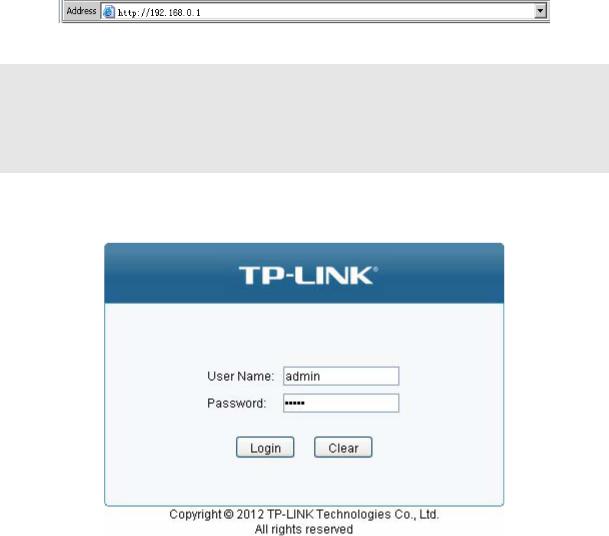
Chapter 3 Login to the Switch
3.1Login
1)To access the configuration utility, open a web-browser and type in the default address http://192.168.0.1 in the address field of the browser, then press the Enter key.
Figure 3-1 Web-browser
 Tips:
Tips:
To log in to the Switch, the IP address of your PC should be set in the same subnet addresses of the Switch. The IP address is 192.168.0.x ("x" is any number from 2 to 254), Subnet Mask is 255.255.255.0. For the detailed instructions as to how to do this, please refer to Appendix B.
2)After a moment, a login window will appear, as shown in Figure 3-2. Enter admin for the User Name and Password, both in lower case letters. Then click the Login button or press the Enter key.
Figure 3-2 Login
3.2 Configuration
After a successful login, the main page will appear as Figure 3-3, and you can configure the function by clicking the setup menu on the left side of the screen.
8
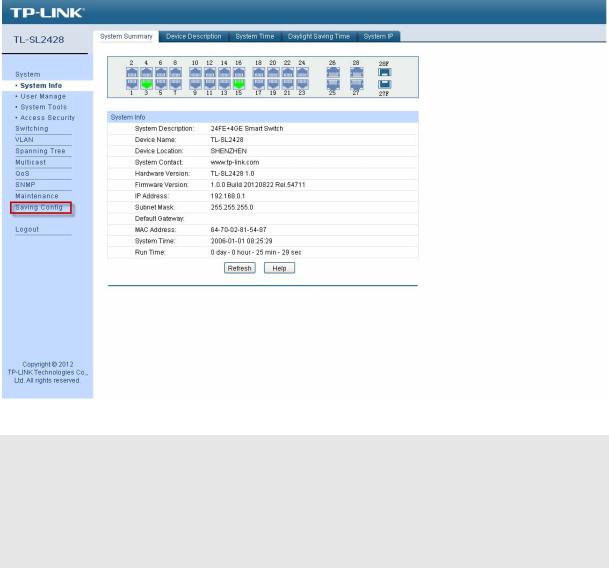
Figure 3-3 Main Setup-Menu
 Note:
Note:
Clicking Apply can only make the new configurations effective before the switch is rebooted. If you want to keep the configurations effective even the switch is rebooted, please click Saving Config. You are suggested to click Saving Config before cutting off the power or rebooting the switch to avoid losing the new configurations.
Return to CONTENTS
9
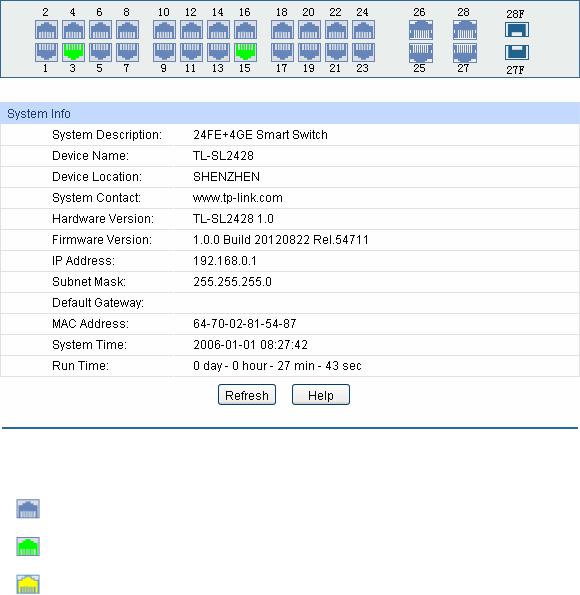
Chapter 4 System
The System module is mainly for system configuration of the switch, including four submenus:
System Info, User Manage, System Tools and Access Security.
4.1 System Info
The System Info, mainly for basic properties configuration, can be implemented on System Summary, Device Description, System Time, Daylight Saving Time and System IP pages.
4.1.1 System Summary
On this page you can view the port connection status and the system information.
The port status diagram shows the working status of 24 10/100Mbps RJ45 ports, 4 10/100/1000Mbps RJ45 ports and 2 SFP ports of the switch. The ports labeled as 1-24 are 10/100Mbps ports; the ports labeled as 26-28 are 10/100/1000Mbps ports; the ports labeled as 27F and 28F are SFP ports.
Choose the menu System→System Info→System Summary to load the following page.
Figure 4-1 System Summary
Port Status
Indicates the 100Mbps port is not connected to a device.
Indicates the 100Mbps port is at the speed of 100Mbps.
Indicates the 100Mbps port is at the speed of 10Mbps.
10

Indicates the 1000Mbps port is not connected to a device.
Indicates the 1000Mbps port is at the speed of 1000Mbps.
Indicates the 1000Mbps port is at the speed of 10Mbps or 100Mbps.
Indicates the SFP port is not connected to a device.
Indicates the SFP port is at the speed of 1000Mbps.
Indicates the SFP port is at the speed of 100Mbps.
When the cursor moves on the port, the detailed information of the port will be displayed.
|
Figure 4-2 Port Information |
Port Info |
|
Port: |
Displays the port number of the switch. |
Type: |
Displays the type of the port. |
Speed: |
Displays the maximum transmission speed of the port. |
Status: |
Displays the connection status of the port. |
Click a port to display the bandwidth utilization on this port. The actual rate divided by theoretical maximum rate is the bandwidth utilization. Figure 4-3 displays the bandwidth utilization monitored every four seconds. Monitoring the bandwidth utilization on each port facilitates you to monitor the network traffic and analyze the network abnormities.
11

|
Figure 4-3 Bandwidth Utilization |
Bandwidth Utilization |
|
Rx: |
Select Rx to display the bandwidth utilization of receiving packets |
|
on this port. |
Tx: |
Select Tx to display the bandwidth utilization of sending packets |
|
on this port. |
4.1.2 Device Description
On this page you can configure the description of the switch, including device name, device location and system contact.
Choose the menu System→System Info→Device Description to load the following page.
Figure 4-4 Device Description
The following entries are displayed on this screen:
Device Description
Device Name: Enter the name of the switch.
12
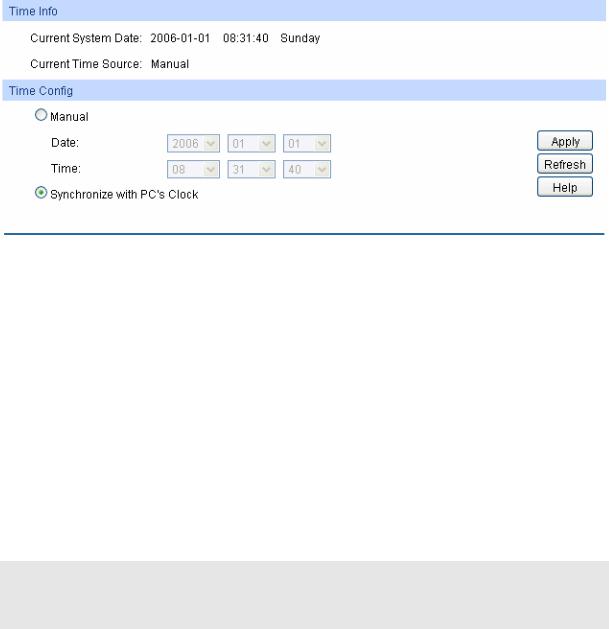
Device Location: Enter the location of the switch.
System Contact: Enter your contact information.
4.1.3 System Time
System Time is the time displayed while the switch is running. On this page you can configure the system time and the settings here will be used for other time-based functions like ACL.
You can manually set the system time, or synchronize with PC’s clock as the system time. Choose the menu System→System Info→System Time to load the following page.
Figure 4-5 System Time
The following entries are displayed on this screen:
Time Info
Current |
System |
Displays the current date and time of the switch. |
Date: |
|
|
Current |
Time |
Displays the current time source of the switch. |
Source: |
|
|
Time Config
Manual: When this option is selected, you can set the date and time
|
|
manually. |
Synchronize |
with |
When this option is selected, the administrator PC’s clock is |
PC’S Clock: |
|
utilized. |

 Note:
Note:
The system time will be restored to the default when the switch is restarted and you need reconfigure the system time of the switch.
4.1.4 Daylight Saving Time
On this page you can configure the Daylight Saving Time of the switch, including DST Status, Predefined Mode, Recurring Mode and Date Mode.
Choose the menu System→System Info→Daylight Saving Time to load the following page.
13
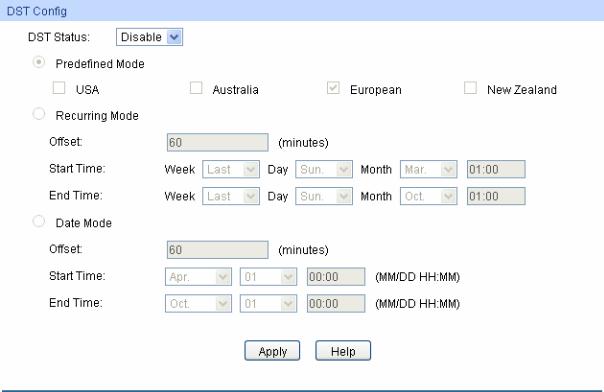
|
|
Figure 4-6 System Time |
The following entries are displayed on this screen: |
||
DST Status: |
Enable or Disable the DST. |
|
Predefined Mode: |
Select a predefined DST configuration. |
|
|
USA: First Sunday in April, 02:00 ~ Last Sunday in October, |
|
|
|
02:00. |
|
|
Australia: First Sunday in October, 02:00 ~ First Sunday in |
|
|
April, 03:00. |
|
|
European: Last Sunday in March, 01:00 ~ Last Sunday in |
|
|
October, 01:00. |
|
New Zealand: First Sunday in October, 02:00 ~ Last Sunday in |
|
|
|
March, 03:00. |
Recurring Mode: |
Specify the DST configuration in recurring mode. This |
|
|
configuration is recurring in use. |
|
|
|
Offset: Specify the time adding in minutes when Daylight |
|
|
Saving Time comes. |
|
Start/End Time: Select starting time and ending time of Daylight |
|
|
|
Saving Time. |
Date Mode: |
Specify the DST configuration in Date mode. This configuration is |
|
|
one-off in use. |
|
|
|
Offset: Specify the time adding in minutes when Daylight |
|
|
Saving Time comes |
Start/End Time: Select starting time and ending time of Daylight Saving Time
14
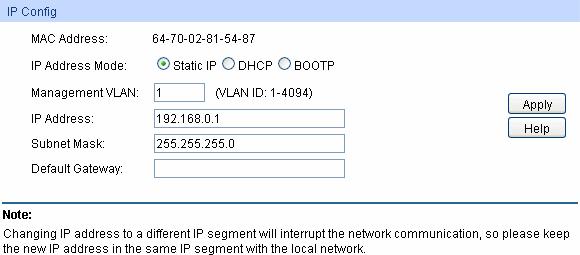
4.1.5 System IP
Each device in the network possesses a unique IP Address. You can log on to the Web management page to operate the switch using this IP Address. The switch supports three modes to obtain an IP address: Static IP, DHCP and BOOTP. The IP address obtained using a new mode will replace the original IP address. On this page you can configure the system IP of the switch.
Choose the menu System→System Info→System IP to load the following page.
Figure 4-7 System IP
The following entries are displayed on this screen:
IP Config
MAC Address: Displays MAC Address of the switch.
IP Address Mode: Select the mode to obtain IP Address for the switch.
Static IP: When this option is selected, you should enter IP Address, Subnet Mask and Default Gateway manually.
DHCP: When this option is selected, the switch will obtain network parameters from the DHCP Server.
BOOTP: When this option is selected, the switch will obtain network parameters from the BOOTP Server.
Management VLAN: Enter the ID of management VLAN, the only VLAN through which you can get access to the switch. By default VLAN1 owning all the ports is the Management VLAN and you can access the switch via any port on the switch. However, if another VLAN is created and set to be the Management VLAN, you may have to reconnect the management station to a port that is a member of the Management VLAN.
IP Address: Enter the system IP of the switch. The default system IP is 192.168.0.1 and you can change it appropriate to your needs.
Subnet Mask: Enter the subnet mask of the switch.
Default Gateway: Enter the default gateway of the switch.
15

 Note:
Note:
1.Changing the IP address to a different IP segment will interrupt the network communication, so please keep the new IP address in the same IP segment with the local network.
2.The switch only possesses an IP address. The IP address configured will replace the original IP address.
3.If the switch gets the IP address from DHCP server, you can see the configuration of the switch in the DHCP server; if DHCP option is selected but no DHCP server exists in the network, the switch will keep obtaining IP address from DHCP server until success.
4.If DHCP or BOOTP option is selected, the switch will gets network parameters dynamically from the Internet, so IP address, subnet mask and default gateway can not be configured.
5.By default, the default IP address is 192.168.0.1.
4.2 User Manage
User Manage functions to configure the user name and password for users to log on to the Web management page with a certain access level so as to protect the settings of the switch from being randomly changed.
The User Manage function can be implemented on User Table and User Config pages.
4.2.1 User Table
On this page you can view the information about the current users of the switch. Choose the menu System→User Manage→User Table to load the following page.
Figure 4-8 User Table
4.2.2 User Config
On this page you can configure the access level of the user to log on to the Web management page. The switch provides two access levels: Guest and Admin. The guest only can view the settings without the right to configure the switch; the admin can configure all the functions of the switch. The Web management pages contained in this guide are subject to the admin’s login without any explanation.
Choose the menu System→User Manage→User Config to load the following page.
16
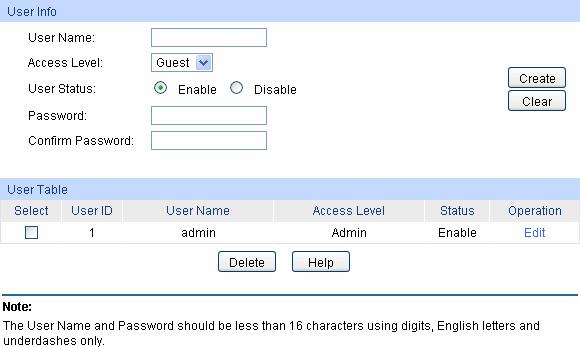
Figure 4-9 User Config
The following entries are displayed on this screen:
User Info
User Name: Create a name for users’ login.
Access Level: Select the access level to login.
Admin: Admin can edit, modify and view all the settings of different functions.
Guest: Guest only can view the settings without the right to edit and modify.
User Status: |
Select Enable/Disable the user configuration. |
Password: |
Type a password for users’ login. |
Confirm Password: |
Retype the password. |
User Table
Select: Select the desired entry to delete the corresponding user
User ID, Name, Access Level and status:
Operation:
information. It is multi-optional The current user information can’t be deleted.
Displays the current user ID, user name, access level and user status.
Click the Edit button of the desired entry, and you can edit the corresponding user information. After modifying the settings, please click the Modify button to make the modification effective. Access level and user status of the current user information can’t be modified.
17
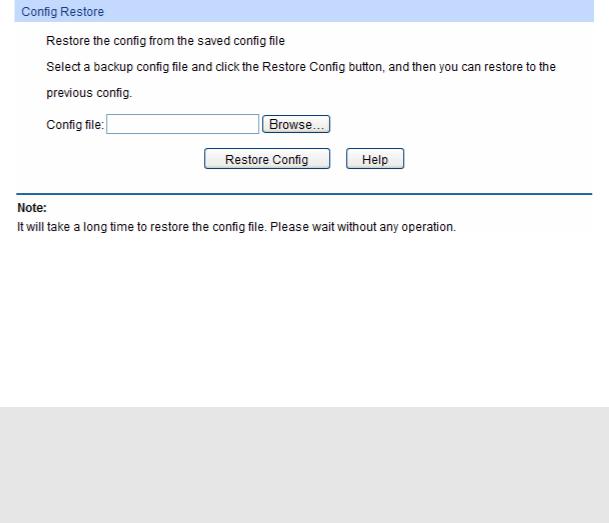
4.3 System Tools
The System Tools function, allowing you to manage the configuration file of the switch, can be implemented on Config Restore, Config Backup, Firmware Upgrade, System Reboot and System Reset pages.
4.3.1 Config Restore
On this page you can upload a backup configuration file to restore your switch to this previous configuration.
Choose the menu System→System Tools→Config Restore to load the following page.
Figure 4-10 Config Restore
The following entries are displayed on this screen:
Config Restore
Restore Config: Click the Restore Config button to restore the backup
configuration file. It will take effect after the switch automatically reboots.

 Note:
Note:
1.It will take a few minutes to restore the configuration. Please wait without any operation.
2.To avoid any damage, please don’t power down the switch while being restored.
3.After being restored, the current settings of the switch will be lost. Wrong uploaded configuration file may cause the switch unmanaged.
4.3.2 Config Backup
On this page you can download the current configuration and save it as a file to your computer for your future configuration restore.
Choose the menu System→System Tools→Config Backup to load the following page.
18

Figure 4-11 Config Backup
The following entries are displayed on this screen:
Config Backup
Backup Config: Click the Backup Config button to save the current configuration
as a file to your computer. You are suggested to take this measure before upgrading.

 Note:
Note:
It will take a few minutes to backup the configuration. Please wait without any operation.
4.3.3 Firmware Upgrade
The switch system can be upgraded via the Web management page. To upgrade the system is to get more functions and better performance. Go to http://www.tp-link.com to download the updated firmware.
Choose the menu System→System Tools→Firmware Upgrade to load the following page.
Figure 4-12 Firmware Upgrade

 Note:
Note:
1.Don’t interrupt the upgrade.
2.Please select the proper software version matching with your hardware to upgrade.
3.To avoid damage, please don't turn off the device while upgrading.
19

4.After upgrading, the device will reboot automatically.
5.You are suggested to backup the configuration before upgrading.
4.3.4 System Reboot
On this page you can reboot the switch and return to the login page. Please save the current configuration before rebooting to avoid losing the configuration unsaved.
Choose the menu System→System Tools→System Reboot to load the following page.
Figure 4-13 System Reboot
 Note:
Note:
To avoid damage, please don't turn off the device while rebooting.
4.3.5 System Reset
On this page you can reset the switch to the default. All the settings will be cleared after the switch is reset.
Choose the menu System→System Tools→System Reset to load the following page.
Figure 4-14 System Reset
 Note:
Note:
After the system is reset, the switch will be reset to the default and all the settings will be cleared.
4.4 Access Security
Access Security is configured to control the users logging on to the Web management page.
On this page you can control the users logging on to the Web management page to enhance the configuration management security. The definitions of Admin and Guest refer to 4.2 User Manage.
Choose the menu System→Access Security→Access Control to load the following page.
20
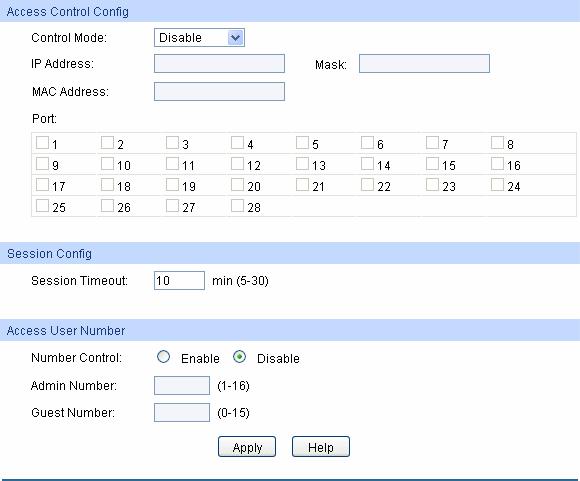
Figure 4-15 Access Control
The following entries are displayed on this screen:
Access Control Config
Control Mode: Select the control mode for users to log on to the Web
|
management page. |
|
IP-based: Select this option to limit the IP-range of the users for |
|
login. |
|
MAC-based: Select this option to limit the MAC Address of the |
|
users for login. |
|
Port-based: Select this option to limit the ports for login. |
IP Address&Mask |
These fields can be available for configuration only when IP-based |
|
mode is selected. Only the users within the IP-range you set here |
|
are allowed for login. |
MAC Address: |
The field can be available for configuration only when MAC-based |
|
mode is selected. Only the user with this MAC Address you set |
|
here is allowed for login. |
Port: |
The field can be available for configuration only when Port-based |
|
mode is selected. Only the users connected to these ports you set |
|
here are allowed for login. |
21
Session Config
Session Timeout: If you do nothing with the Web management page within the
timeout time, the system will log out automatically. If you want to reconfigure, please login again.
Access User Number
Number Control Select Enable/Disable the Number Control function.
Admin Number: Enter the maximum number of the users logging on to the Web management page as Admin.
Guest Number: Enter the maximum number of the users logging on to the Web management page as Guest.
Return to CONTENTS
22

Chapter 5 Switching
Switching module is used to configure the basic functions of the switch, including four submenus:
Port, LAG, Traffic Monitor and MAC Address.
5.1 Port
The Port function, allowing you to configure the basic features for the port, is implemented on the
Port Config, Port Mirror, Port Security and Port Isolation pages.
5.1.1 Port Config
On this page, you can configure the basic parameters for the ports. When the port is disabled, the packets on the port will be discarded. Disabling the port which is vacant for a long time can reduce the power consumption effectively. And you can enable the port when it is in need.
The parameters will affect the working mode of the port, please set the parameters appropriate to your needs.
Choose the menu Switching→Port→Port Config to load the following page.
Figure 5-1 Port Config
Here you can view and configure the port parameters.
Port Config
Port Select: |
Click the Select button to quick-select the corresponding port |
|
based on the port number you entered. |
Select: |
Select the desired port for configuration. It is multi-optional. |
|
23 |
